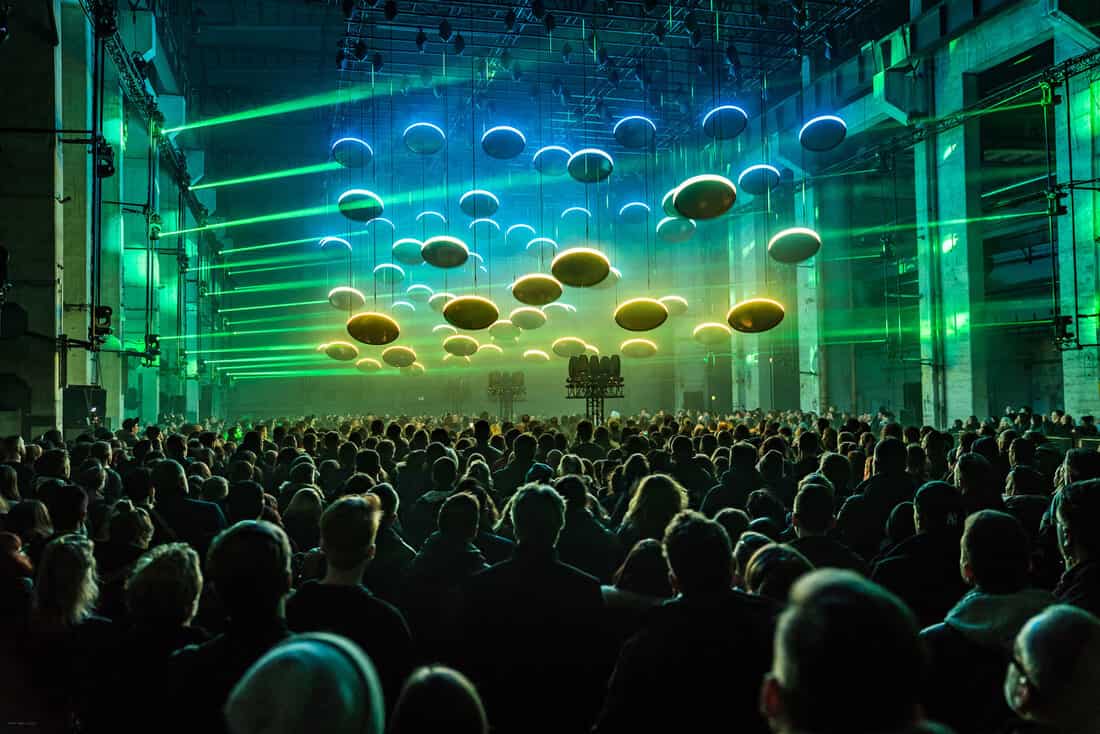
“Hold it, no further,” someone shouts down from a hydraulic lift. “Yes, it’s high enough.” The rattling sound of steel chains stops. The lamp construction hangs and the spotlights go on. In the hall, the different projects light up. Some more complete than others, you can hear drilling and hammering. Innovation Origins visits the Klokgebouw, where from tomorrow DDW will start. Mind the step is one of the exhibitions. The Technical Universities of Eindhoven, Twente, and Delft show how technology, design and research come together. About 150 students and researchers will show their work to the many visitors who can visit the Klokgebouw until 28 October.
But before the first visitors can enter, there is some work to be done. Two men walk past with a large roll of carpet on their shoulders, they have to avoid a warning sign: watch out, wet! Almost, they had given someone a portion of extra work, they smile the fright away and walk on. Large banners on the ceiling of the hall divide the exhibition into different subjects.
New Mobility
The ‘usual suspects’ of the TU/e are all set for DDW. Stella Vie, the first solar-powered family car that is legally allowed to drive on public roads, has a nice spot at the entrance. And also the electric racing car developed by University Racing Eindhoven is not to be missed. The big absent one in this New Mobility corner is Vision. The electric car, made by the student team InMotion. They have the ambitious plan to be the first to complete the Le Mans 24 Hours with an electric car. However, a survey learns that they will be in the Klokgebouw tomorrow.
(the text continues after the image)

New Materials
Under this banner new materials and processing methods can be found. From pigment-producing bacteria to colour textiles and leather, to personalised 3D printed goalkeeper gloves or insoles to prevent injuries among cyclists. Here you will also find graduates who want to contribute to a more efficient use of the production material. Because did you know that mussel shells can also be used to print a lampshade? Mariet Sauerwein of Delft University of Technology was bothered by the amount of plastic that 3D printers use. She discovered that mussel shells, of which 20 million kilos of mussel shells are discarded every year in a click, work well in a ground form in a 3D printer. Unlike plastic, her material is completely suitable for reuse.
Further down stands Arthur van Lier, who is studying at the TU/e and is working on the last of about six hundred nuts and bolts in his wooden span. “If I design something like this again, I have to think of something for it,” he says laughing. Van Lier wanted to bend wood without using traditional processes like laminating or steaming. “These are expensive processes that require a lot of wood. By trying a lot and playing with plywood and computer models I came up with a method to create a light, yet solid construction.” The arch is created by attaching two plates, different in length, to each other in a certain pattern. This creates tension which causes the wood to bend. “You need less wood than with traditional methods and it is less labour-intensive, it only needs to be sawn out.” It could be a nice railway station roof. “Or you can integrate it into the structure during construction. In a hall like this, for example,” he adds.

The arch is now mainly a prototype and according to van Lier needs some extra research before it can really be used. “It can be scaled up with thicker and larger plates,” Van Lier tells while tightening another nut. “I also tried to attach the plates in a different pattern; for more tension and strength. But for this, I need more time to investigate what works best.” When asked, if he wants to elaborate this further: “Only if it would be a specific project.”
Design for debate
Meanwhile, the hall is getting fuller and the exhibition is taking shape. During Mind the Step there will also be more conceptual projects, such as the Smart Migrants Dispenser. Here, three students of Industrial Design from Delft assume that every family in the Netherlands must take in a migrant. With their interactive machine, they determine which migrant would be best suited to you and does he fit in with the family? Can you make a choice in this? This should make visitors think, just like another project from Delft: Valoranima. They only make oxygen available to people with good social values. People who help elderly cross the street get oxygen, people who steal don’t. These projects should mainly evoke discussion.
In total there are six pillars to be found at Mind the Step. Click here for an overview of all projects. Last year Innovation Origins made this report:







